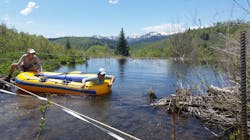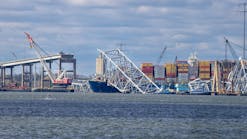Simple mapping can estimate beaver ponds’ nitrogen cycling
A new study shows how simple mapping of a beaver pond’s depth and sediment can tell managers whether it’s a nitrogen source or sink, according to a press release from the American Geophysical Union.
Beaver ponds contain nitrogen, an essential nutrient that can become a pollutant when too much is present. Land managers need to know if beaver ponds are storing or releasing nitrogen, but chemical testing can be expensive.
The study was published in the Journal of Geophysical Research: Biogeosciences, which publishes research on the interactions between biologic, geologic and chemical processes across Earth’s ecosystems.
Previous studies have found that nitrogen can be either higher or lower downstream from beaver ponds. But few studies have closely examined what happens to nitrogen within a beaver pond, leaving open the question of whether beaver ponds tend to be good or bad for nitrogen pollution and whether beavers should be reintroduced to the ecosystem.
“It depends on the river but, for sites like the one we studied, reintroducing beavers could be a wise decision,” said Desneiges Murray, a biogeochemist who led the study. “These ecosystems evolved with beavers in the first place. So, the combined effects of less erosion, better resistance to forest fires, more water storage during droughts, and now the benefit of long-term nitrogen storage — there are lots of reasons humans should be facilitating beaver recolonization into their natural habitats.”
During the 1600s to 1800s, between 25 to 160 million beavers were hunted to near extinction in the contiguous United States. By the late 1980s, they had recovered to between 6 and 12 million beavers; today, efforts to reintroduce beavers are taking place around the United States, with varying success and popularity.
The new study maps zones within a beaver pond system, called a complex, nestled in the Bear River Mountains north of Salt Lake City.
Murray and her co-authors defined five zones based on water flow, pond depth, and sediment thickness and grain size. They gathered data on how much nitrogen and oxygen were in the water in different zones, collected samples of pond sediments, and took long cores of sediment to analyze nutrient changes over time. Then they mapped it all, paying special attention to the ratio of sediment depth and water depth.
“This new approach of looking at geomorphic units within a beaver complex is going to be helpful for understanding why beavers reduced nitrogen, or heavy metals, or acid mine drainage,” said Emily Fairfax, a hydrologist at California State University-Channel Islands not involved in the study.
Most nitrogen enters beaver ponds as dissolved and particulate nitrogen. Once in the pond’s sediments, nitrogen can go through chemical transformations into other forms, such as ammonium, inert nitrogen gas, or reactive nitrogen dioxide gas, which can degrade ozone in the atmosphere.
The researchers found the beaver pond was storing up to 15% of the nitrogen that came in, mostly in the sediments of the backwater zone. The backwater zone has thicker organic-rich sediments and the low oxygen concentrations necessary for nitrogen to convert to inert nitrogen gas, which can be stored. Other zones, with less sediment or more oxygen, weren’t able to store as much nitrogen.
It’s the first such correlation between a beaver pond’s small-scale geomorphology and nitrogen, and it opens the door to new ways of assessing nutrients in beaver ponds.
A big takeaway for Murray is that mapping the zones of beaver ponds is a powerful tool on its own — land managers could skip the chemical analyzes if they’re just looking for an estimate of nitrogen cycling. Ponds with thicker organic-rich sediments and shallow, low-oxygen water are more likely to store nitrogen; faster-moving ponds with more oxygen and less sediment are more likely to release nitrogen.
“The experiments we conducted are difficult, time-consuming and expensive,” making mapping a simpler and cheaper alternative, Murray said. “This tight relationship we found between the shape of a beaver pond and its chemistry is really compelling, and those are basic measurements anyone with a science background could conduct.”
The new research is a case study of a specific site, but Fairfax thinks the mapping approach will be useful wherever beavers are found.
“They’ve identified the important zones for denitrification and nutrient processing, and that has a lot of potential because beavers don’t build the exact same dams,” Fairfax said. She also highlighted the importance of local studies.
“Policies won’t change unless decision makers see local data,” Fairfax said. “I haven’t seen many studies on beavers’ impact on nutrient loads in the West, so this is a really valuable case study to add to the literature.”






